The woman’s legs seemed to go on forever. It was hard to tell exactly whom they belonged to, or what she was thinking, but their purpose was clear, dominating a billboard for a new condo…. drawing the eyes of admirers and critics alike. “Look up,” implored a line of text floating across her toned thighs, just below the bottom hem of her black mini-dress. And then, in case we didn’t get the message: “Way up!” … Posters placed above urinals in bar washrooms cooed that a down payment on a Midtown Calgary apartment was “as easy as 25-year-old scotch , or a 25-year-old blonde on 25-year-old scotch.” Fair or foul? Sex does sell, and it has had a long and complex relationship to blondes, and the role of gender, race, power and privilege in patriarchal Western culture; variations on themes that have been around at least since the Greek poet’s Seneca and Homer…..

The posters, which were placed in men’s washrooms at several nightclubs, where designed to appeal to young professional men in the downtown area
”A hard man is good to find./A man has one hundred dollars and you leave him with two dollars, that’s subtraction./A woman in love can’t be reasonable – or she probably wouldn’t be in love./All discarded lovers should be given a second chance, but with somebody else./An ounce of performance is worth pounds of promises./Any time you got nothing to do – and lots of time to do it – come on up./Between two evils, I always pick the one I never tried before/.Cultivate your curves – they may be dangerous but they won’t be avoided./Don’t keep a man guessing too long – he’s sure to find the answer somewhere else./Every man I meet wants to protect me. I can’t figure out what from/Give a man a free hand and he’ll run it all over you./He’s the kind of man a woman would have to marry to get rid of./Is that a pistol in your pocket or are you just glad to see me?/ Likewise, “When I’m good, I’m very good. When I’m bad, I’m better,” (Mae West)
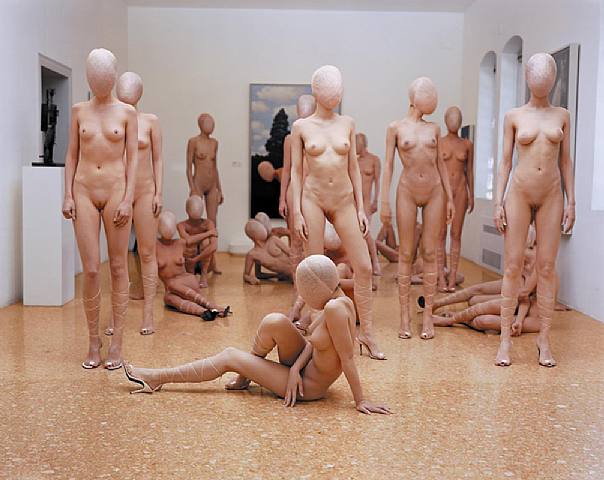
"I'd like to call Vanessa Beecroft the Leni Riefenstahl of performance art, but that wouldn't be fair. Her fascism's fake: No menace or power or insanity, beyond capital, underwrites her project. (She described VB45, her February performance at the Kunsthalle Wien, in which forty-five women stood around wearing nothing but thigh-high black boots by Helmut Lang, as "Nazi-looking.")"
A somewhat dated melodrama, “She Done Him Wrong” features the oft-misquoted Mae West line, “Why don’t you come up sometime ‘n see me?” Based on a stage play that West herself helped write – the scandalous, “Diamond Lil”, – “She Done Him Wrong” kicked off the institution of a tough Hollywood production code. The overtly sexy, seductive Mae West and her double entendres in She Done Him Wrong set the stage for decades of blue-nose censorship, and the life of the blonde has never rebounded since; desire as a something raw and subversive has been dressed like a french show poodle since, or at best a kind of hybrid in Marilyn Monroe.
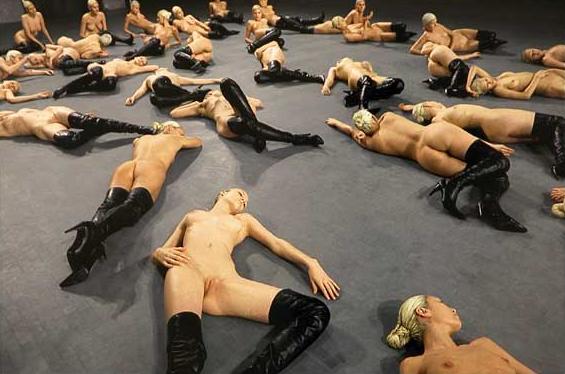
"Beecroft is famously fascinated by "the mystery and opacity of women," men being "too transparent and abstract," but seems never to have wondered about the fact that power/authority seems to go primarily to those who have the freedom to be removed and absent. I'm not sure which would be more depressing--that she thinks hairless crotches somehow do not signify or, alternatively, that she thinks they somehow interrogate the modeling and culture industries' infantilization of women. Beecroft's early-'90s performances and drawings had a raw awkwardness and used her own body fascism (eating disorders) to choreograph the confluence of vicious control and hungry stupor."
No blonde has influenced the significance of being blonde more than Marilyn Monroe; Monroe promoted and helped codify the standardized images of blondes as a mark of whiteness, sexually receptive, vulnerable, unintelligent, innocent and a symbol for a desire to attain a central and highly visible position in society. Most critical, fictional, or clearly fantasy depictions of Marilyn Monroe’s life, eventually, after the fatigue sets in, turns to a reflection on the construction of white self in its natural and contrived formulations, both as a means of identity, and a parody of the symbolism. The phenomenon of the blonde is both a racialization of the white female identity and part of a complex dialogue between social practices and individual subjection and reaction to it; a sensitive and divisive subject; Construction of the blonde myth, a default gendered, and racialized identity, is a complex and anxiety-ridden negotiation.Cultural representations of the individual’s engagement with the white ideal highlights both a female’s desires and anxieties about the idea of race. Thus, the racialization works both as defining and limiting to white female identity.
” The identification of blonde with purity, superiority, or happiness becomes not merely a cultural preference, but a powerful fetish that subjugates and devalues those who are not blonde. Being blond fulfills the conditions of the myth and perpetuates the notion which originated in a dominant white culture that fairness is superior to darkness… and in the people who profit economically by supplying the means for fulfilling the dream.” ( Holliday T. Day )
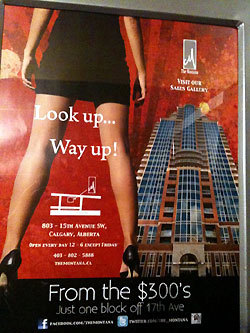
"A woman who answered the phone at the Montana's sales centre said, "It's just amazing what good advertising can do," before referring interview requests to the sales manager who was out of town. ProCura, the developer of the Montana, boasts of donating $1,000 from the sale of each unit to the Famous 5 Foundation, a non-profit group dedicated to preserving the legacy of famed Canadian suffragists and women's rights advocates."
Blondes are a potent sign in Western visual culture. In a culture dominated by visibility the construction of the modern archetypal blonde is a testament of marketing prowess and social engineering. The word blonde is almost a one word oxymoron since it holds an emotional charge and a range of meanings that are generally contradictory; a classic dichotomy that oscillates between desire and derision as it has morphed, in the hands of Hollywood, into a noun, an end in itself, as opposed to the previous role it
ed as an adjective until the 1930′s. These new aggregates of meaning could be widely disseminated through what Adorno called the ”Culture Industries” which in the case of blondes, served to commodify identity and establish what has appeared to be an enduring identity, with the line between culture and product being totally blurred.
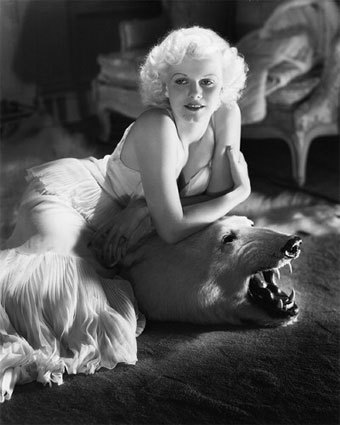
"She was known as The Blond Bombshell. If you look at the studio portraits by George Hurrell you assume she was just another heavy-lidded, sexy star. But Jean Harlow's true talent was as a comedienne. Friends described her as casual and fun loving with no pretense whatsoever. She held the unofficial dice record at Agua Caliente Casino in Mexico, with thirty-four straight passes. Harlow's humorous attitude comes across best in Dinner at Eight. She delivers her lines with machine-gun precision, her natural wit punctuating the spaces between her sentences."
At the same time, a Mae West or Jean Harlow established an ironic engagement with the phenomenon that was both conforming and subversive with the intentional parody of excessive feminization being ambiguous, unpredictable and volatile. Artists and scholar Laini Burton paints blondes, often just the hair of famous blondes such as Monroe and Harlow; even without their faces, they are instantly recognisable, with the absence of the faces in the pictures underlining the mythology attached to blondeness. One of Ms Burton’s achievement in her writing has been to “destabilise the myths” surrounding blondeness. Far from just wanting to have fun and seek attention, she believes,today’s women who opt to be bottle blondes are engaging in “knowing mockery” of a culture that sees blonde women that way.
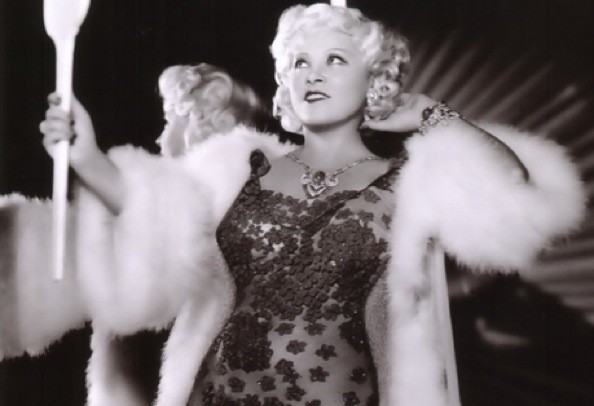
"Mae West was known for pushing her limits, in all senses of the term: censors didn't know what to make of her provocative look or her naughty double entendres. Still, she was one of the most glorious stars of the 1930s and early 40s - and a major fashion plate."
Blondes didn’t always have most fun. In 1920s America, “dark, lustrous curls or smooth, glossy expanses of straight raven hair had been the ultimate expression of feminine beauty”. Blonde hair was associated with “low-class promiscuity”. One of Joanne Pitman’s many eminently quotable anecdotes is how, at a Hollywood party in the early 1930s, Jean Harlow asked Margot Asquith how to pronounce her first name. She replied” “The ‘T’ is silent, as in Harlow.”Pitman argues that the colouring of our capillaries is an important part of political history. Roosevelt’s New Deal went hand in hand with the increasing popularity of hair dye; in an age of optimism, the incorruptible blonde became a symbol of America’s superiority. Shirley Temple, who wore her golden curls like a halo, tap-danced the public out of the Depression. Elsewhere, Stalin and Hitler endorsed blondeness as a means of expressing national hegemony. It came to symbolise health, heroism and racial purity.
…Eventually all roads lead to Marilyn Monroe. Punks may have tried to subvert the image, but Monroe’s luminescent candyfloss hair endures as the archetype; there cannot be a woman who can honestly say she wouldn’t want a little of what Monroe had.Certainly, whether created by nature, artists or beauty parlours, blondes through the ages have rarely been ignored. Pitman starts her story in 360 BC, when Praxiteles may have used his mistress, Phryne, as his model for a statue of a blonde Aphrodite, who came to represent all forms of love.The statue was endlessly reproduced, inspiring prostitutes to find ways to lighten their hair. The poet Menander decreed that “no chaste woman ought to make her hair yellow,” but Homer preferred to imagine Aphrodite emerging from the sea wearing nothing but her blonde tresses.
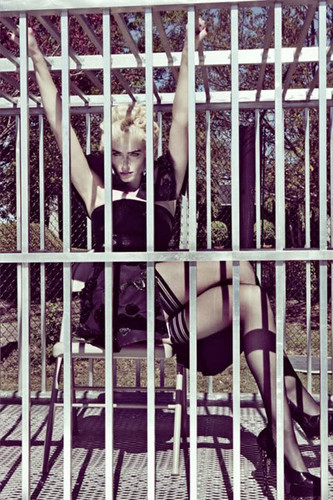
"Without doubt, Aphrodite earned her reputation for frivolity and promiscuity as a result of her very liberated sexuality. However, this reputation was not so much a condemnation of her behavior as it was a fear of her uncontrollable nature. Aphrodite was one of the most unique of the Greek deities in the freedom of her sexual life. Aphrodite's charms came from her magic cestus, an embroidered girdle that, in both gods and men, aroused passion for the wearer. So great were Aphrodite's seductive abilities that every god, including the great Zeus, desired her as his wife."
In Roman times, the role of Aphrodite was assumed by Venus, another erotic goddess portrayed with golden locks. Again, she inspired prostitutes to hit the peroxide bottle, but the look also caught on as naturally blonde Germans were taken to Rome as slaves by conquering armies. By the third century A.D., Christian preachers had concluded that the blonde and naked Venus was evil, yet lightening the hair or wearing a blonde wig remained a popular way of standing out among the dark-haired Romans.
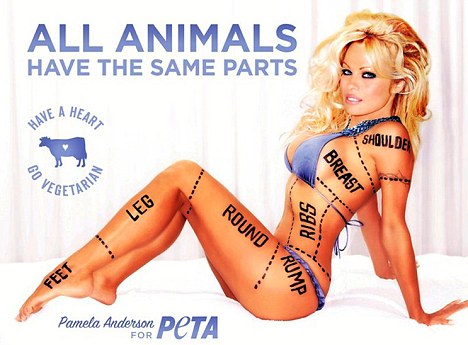
"Canadian born Anderson was shocked by the ban decision, saying: 'In a city that is known for it's exotic dancing and for being progressive and edgy, how sad that a woman would be banned from using her own body in a political protest. Touch down: Anderson landed in Montreal yesterday to learn her ad had been banned by Montreal city officials 'In some parts of the world women are forced to cover their whole bodies with burqas- is that next? I didn't think Canada would be so puritanical.' And PETA's senior Vice President, Dan Matthews weighed in: 'I think that city officials are looking at this lovely ad and confusing "sexy" with "sexist". Read more: http://www.dailymail.co.uk/
In the Middle Ages, blondes, at least those with dyed hair or wigs, were still considered hussies. By then, Venus had transmogrified into Eve, duly portrayed as a beautiful – and blonde – temptress. In her wake trailed Mary Magdalene, one of her most promiscuous descendants as seen in Masaccio’s 1426 Crucifixion, which shows Mary Magdalene at the foot of the cross, her long, blonde hair tumbling over a vivid red cloak. Simultaneously, however, a battle over the symbolism of blondeness was taking place in other parts of Europe where the Virgin Mary was being portrayed as a blonde. These images were inspired by St Bridget, a 14th-century Swedish holy woman and presumably a blonde herself. Soon blondeness was also representing purity. The fourteenth-century Wilton Diptych by an unknown artist shows a blonde Virgin holding a blonde child surrounded by eleven blonde female angels.
During the Renaissance, the Virgin continued to be portrayed as blonde by Raphael and others, but Venus also returned to fashion – again as a blonde. “Venus,” by Botticelli’s workshop, shows her naked, with only her long blonde hair providing some modesty. Of course, the very streets of Venice offered ample evidence of the power of blondes, not least Lucrezia di Borgia, whose “glowing hair” became the stuff of sonnets.
In 16th-century England, the russet-haired Queen Elizabeth chose blondeness as a symbol of her virginity, and while it is not known if she dyed her hair blonde, this was how she was often portrayed, not only by poets such as Spenser but also by painters. A coronation portrait painted around 1600, 42 years after she came to the throne, shows a young Elizabeth with long blonde hair. The implied association between the Virgin Queen and the Virgin Mary was not accidental.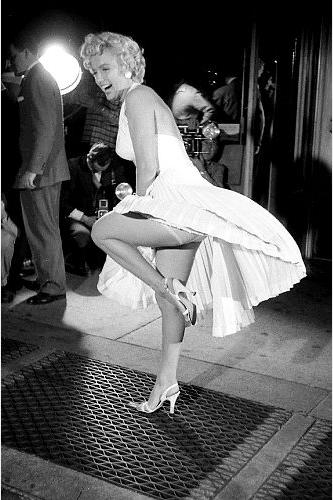
The twentieth century brought the emergence of the blonde as a symbol of racial superiority. Long before Hitler seized power in Germany in 1933, anti-Semitism was accompanied by a new myth of Aryanism, encouraged by the new fad of eugenics; and the interesting parallels between the Nazis’ adulation of blondeness, the Soviet Union’s promotion of the dynamic blonde ideal and “the development of a radiantly sunlit blonde American ideal, the WASP American dream.”
In the United States, though, by the 1940s the vampish images of the likes of Harlow and Mae West had been replaced by “socially well-behaved blondes,” such as the wartime pin-up Betty Grable. Yet within a decade, prudery had again been swept aside, at least partly by Monroe. Soon there were “dumb blondes” such as Mansfield, regal blondes like Kelly and girl-next-door blondes such as Debbie Reynolds. All that’s changed since the ’60s is it has become simpler to become a blonde. Why this continuing fixation with blondeness? Its the construction of the myth; and if this idea was long promoted by poets and painters, it is now constantly drummed into the public by television and magazine advertising.
‘The eternal allure of blondeness, he says, is to do with lustre, a soft brightness, “a thing which is enhanced by light, so they reflect light and glow more strongly”. The blonde, in this way, is the same as gold, or a polished kitchen bench. “Human beings go for things with a sheen to them,” he says. But female blonde hair is also loaded with all kinds of symbolism, signals and stereotypes. The “dumb blonde”, for example, an idea that probably came from the blonde link to young children, only to be reinforced by Hollywood in Jean Harlow and Marilyn Monroe. It’s the “blondes have more fun” thing, the cliche that “gentlemen prefer blondes”.
Various forms of masquerade permeate fairy tales: the crossing of gender or species, the disguising of youth, beauty, or privilege. Masquerade provides benign and temporary conditions under which potentially volatile social hierarchies can be overturned within the rubric of play. …In a highly influential 1929 essay on the topic, psychologist Joan Riviere proposed that women sometimes put on a mask of “womanliness” to avert anxiety.Womanliness, she claimed, disguises masculine ambition and serves as a strategy to avert potential retribution should a woman be found in possession of masculinity, “…much as a thief will turn out his pockets and ask to be searched to prove that he has not stolen the goods.”Making no distinction between what she calls “genuine womanliness” and a more perverse masquerade, Riviere insists that whether “…radical or superficial, they are the same thing,” suggesting that all women have worn the mask at some point.
Although the popularity and desirability of blonde hair in the West is well documented, since the 1950s, blonde hair has also generated many negative associations and these have contributed to myths around blondeness. In particular, women who dye their hair blonde find themselves in a paradoxical position; they simultaneously evoke desire and derision; a transgressive potential of the knowing use of blondeness as a sign. When women wear blondeness in this way they embrace it as an oblique means to access privilege. This self-reflexivity allows women to enter sites of power that they are otherwise excluded from.
To get closer to the roots of the modern quandary, we first have to revisit the Renaissance. For it was during this period (1532-1542) that a Benedictine monk named François Rabelais wrote The Histories of Gargantua and Pantagruel, a folk epic aimed at satirizing the ecclesiastical and social orders of his day through a series of bawdy narratives. Briefly, Gargantua is a giant who, along with his son Pantagruel, travel around the kingdom drinking, vomiting, breaking wind, and making “the beast with two backs” whenever they get the chance. On its own, the text stands as a powerful assertion of unfettered humanism that would evolve to challenge Church doctrine in the coming age of Enlightenment. Once famed critic Mikhail Bakhtin read the work, however, Rabelais’ book yielded even further significance.
In Rabelais and His World, Bakhtin analyzes the realm of the carnival described in The Histories of Gargantua and Pantagruel, and articulates its social meanings both for the participants and their society. The toilet humor that fills Rabelais’ work is, for Bakhtin, not just an ancient equivalent of Porky’s. Instead, it points to an undoing and re-imagination of the social order. When such ridiculousness was at hand, the stern divisions that kept serfs in their fields and kings in their castles disappeared. As Bakhtin puts it, “all were considered equal during carnival…a special form of free and familiar contact reigned among people who were usually divided by the barriers of caste, property, profession, and age.” In other words, the presence of the carnival (announced in a variety of ways, from off-handed fart jokes to the wearing of elaborate costumes) constitutes a particular kind of social revolution, in which social barriers are broken down through the mechanics of laughter.
So what does all of this have to do with died blondes ?; the Pamela Anderson’s and Madonna’s, or Deborah Harry, as it relates to the broader issue of transgression and masquerade. A lot, actually. If we follow Bakhtin’s line of reasoning, we come to understand that running around with a wedge of plastic cheese on one’s head at a Green Bay football game, copying Madonna’s look, or dressing up as a Spice Girl, is the same kind of work, culturally speaking, that was accomplished by flatulent giants, or cross-dressing jesters, or juggling scullery maids so many hundreds of years ago. In short, all of this behavior represents a kind of inversion—albeit a temporary, contained one—of the prevailing social order. It allows participants to enter into a social realm that is separate from the everyday and, as such, not subject to its rules and regulations.

"The white sheet is a symbol of the hymen and virginity yet the wreath and flowers suggests that she is a kind of sacrificial offering. Hovering slightly above her head is a dark shape like a cloud, a hole or a rift. Behind the figure, a graffiti scrawl ‘Wish U were Here?’ is barely legible yet it compounds the rift, the hole, the doubt. The situation is unsettling and the suggested purity and hence immaturity of the subject seems to relate to Williams’ idea that ‘as children, women are taught to be the seductress yet we are ignorant of what to expect or how to deal with it’."
“The symbol of the veil is developed here too as the aggressor of the battle is shrouded by her own hair. The veil of hair is a development of the blank sheet; hair represents burgeoning sexuality yet it is also reminiscent of vengeful women from the furies of Ancient Greece to Sadako in Nakata’s The Ring. The veiled woman is aggressively present, yet there is an uncanny sense of blankness. Williams describes how sometimes ‘the veil refers to the woman not quite knowing who she is – a certain lack of identity’. This explains the frustrated pose of the subject as she grips the hair of a blonde who gazes at some point beyond the frame. The blonde’s lack of awareness of the painful grip on her hair suggests preoccupation, ignorance and blindness. The active stance of the central figure is a stark contrast and there is a sense that two halves of a self are at war as the vengeful victim of betrayal reproaches the new victim for her blind trust.”
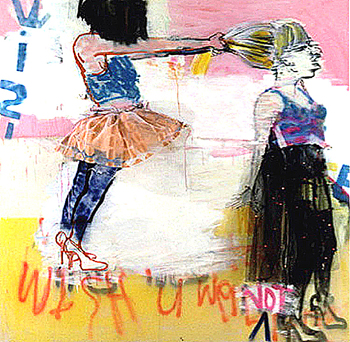
"Sue Williams' paintings embody a passionate response to the human condition, revealing an ambiguous boundary between a secure place and an insecure place, between the real and the imagined. Drawing plays a major role within her work and it is through the use of the drawn image that the notion of human desire and frailty unfolds...."
”…The white sheet then also represents a certain ignorance of heterosexual relations. An interesting comparison is Isak Dinesen’s story ‘The Blank Page’, which tells the story of an order of nuns who weave the royal linen. On the morning after the royal marriage, the linen is hung from the window with evidence of the bride’s virginity. In return for their linen, the nuns receive the central piece of the sheet which they frame in a gallery and hang like art, yet one sheet in the gallery is blank raising questions. Had the bride already lost her virginity? Did she escape marriage altogether with its brutal parading of female pain? We cannot know the story and similarly in Williams’ painting, the white sheet is a blank page, a paradoxical strategy. Jacques Derrida’s description of the hymen as the feminine veil, a site of power, is relevant here and Williams’ mysterious women recall Derrida’s suggestion that the veil both ‘hides and shows the truth of what is present’ ” ( Zoe Brigley )
aaa



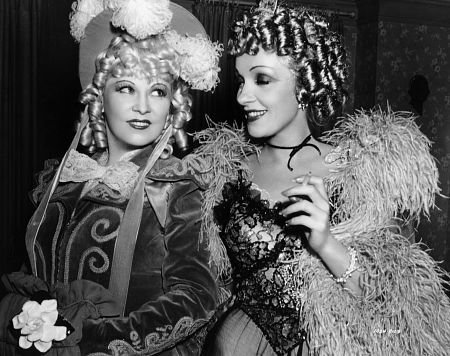


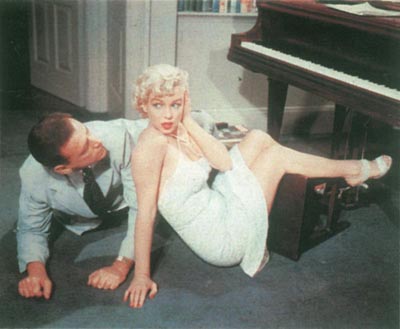
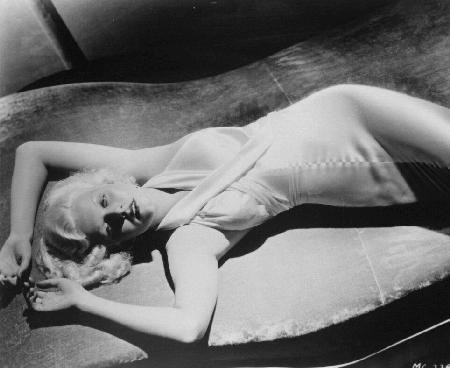
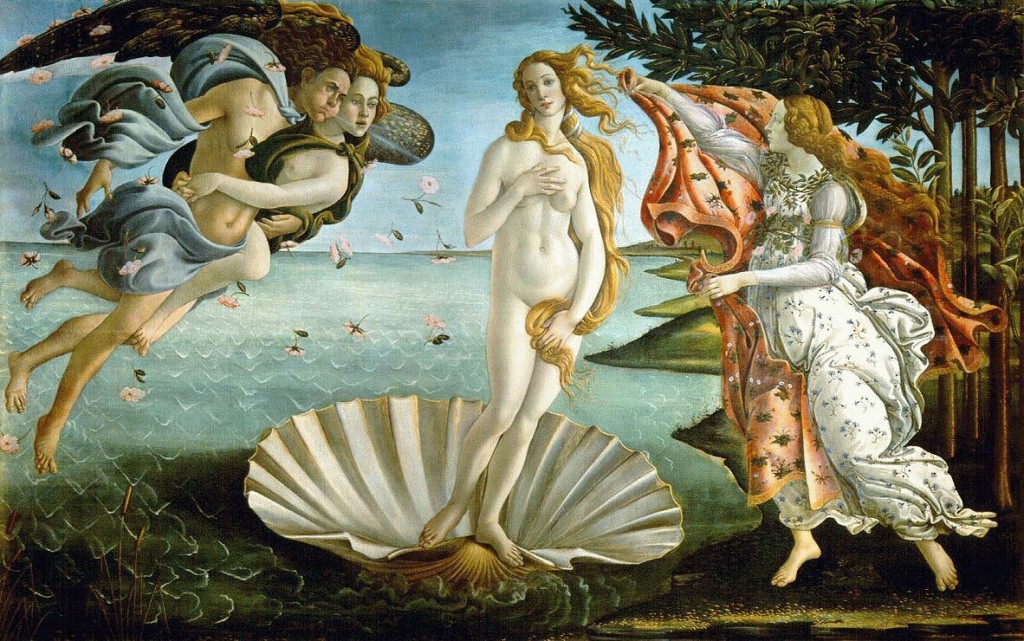





 COMMENTS
COMMENTS



